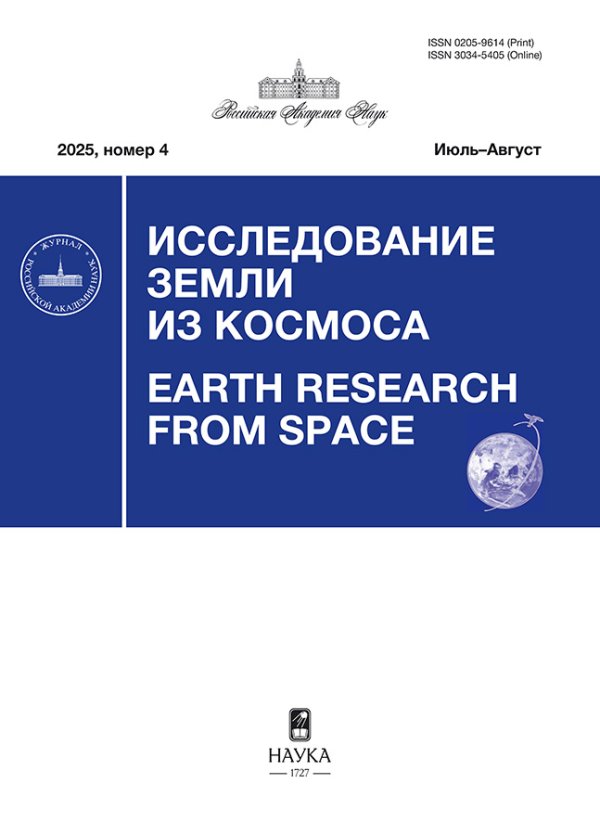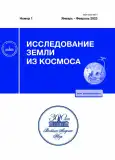No 1 (2023)
ИСПОЛЬЗОВАНИЕ КОСМИЧЕСКОЙ ИНФОРМАЦИИ О ЗЕМЛЕ
Structure of the Earth’s Crust According to the Gravity Data of the GOCE Satellite Mission and Spatial Position of Polymetallic Deposits in the Frame of the Siberian and Eastern European Platforms
Abstract
The results of recent study of the Earth’s crust based on the gravity data of the GOCE satellite were used for a comparative metallogenic analysis of the geodynamic settings of polymetallic deposits in the folded frame of Siberian and East European platforms. It is shown that deposits of the SEDEX type are more often located in the earth’s crust with the predominant development of the lower “basalt” layer. Pyrite copper and lead-zinc deposits (VMS), as well as some occurrences of the SEDEX type, are known in subduction island-arc and accretionary settings on the crust with the predominant development of the middle “granite” layer. Pb–Zn ores of the MVT-type are localized in deep pericratonic sedimentary oil&gas basins on the shelf and continental slope, with no spatial relationship with the stratification of the earth’s crust. The Ag-polymetallic mineralization of Taimyr and Western Verkhoyansk are confined to deep pericratonic rift troughs on the passive continental margin, have a similar ore-bearing environment and may be considered as a single silver-polymetallic Taimyr-West Verkhoyansk belt. The obtained results to confirm the prospects of Pb–Zn deposits in Central and Eastern Taimyr, as well as the Saurey ore region (Polar Urals) and the need for their further research.
 3-23
3-23


Application of Landsat-8 Satellite Data to Predict Ore Mineralization for the Northern Territories on the Example of the Central Part of the Maloural Zone (The Polar Urals)
Abstract
A new approach was developed during this study. It is focused on identifying probabilistic zones of increased fracturing (zones with a high density of lineaments), considered as a predictive feature for the localization of ore mineralization in the central part of the Malouralskaya zone (part the Polar Urals). This area is promising for the identification of ore occurrences of the polymetallic type (Fe, Cu, Cu–Zn, Au–Cu). Density maps of lineaments were built basis on the developed approach. In addition, predictive schemes for the distribution of highly permeable rock zones and promising areas for the polymetallic mineralization was identified, taking into account geological information, the distribution of mineral resources, and the outcome of remote sensing data processing. The last is based on identifying structures by manual and automatic approaches and their integration using the theory of fuzzy logic. Morphostructure maps were obtained from Landsat-8 data. These maps show that the known polymetallic ore occurrences in the region (Cu, Cu–Zn, Cu–Pb–Au, Fe–Ti–V, Cu–Pt) are located along the perimeter of a large morphostructure of the 1st order, or near extended tectonic structures for up to 20 km with mainly NE and less often NW trends. We identified six prospective zones by comparing remote sensing results with the geological map of the studied territory and known ore occurrences. The highlighted areas showed spatial consistency with several known polymetallic ore occurrences.
 24-40
24-40


Satellite-Based Mapping of the Negative Impact of Gold Mining Enterprises on the Natural Environment of the Cryolithozone (On the Example of the Magadan Region)
Abstract
Gold mining at ore and alluvial deposits causes a substantial negative impact on the natural environment, in particular land degradation and contamination of watercourses with suspended solids. In this study, we consider a methodology for identifying and mapping the negative impact of gold mining enterprises on the natural environment based on a long-term series of free-available Landsat and Sentinel-2 satellite images. The study was carried out on the example of Tenkinsky, Susumansky and Yagodninsky districts of the Magadan region, where the largest gold deposits are located. Identification features of active mining areas, as well as abandoned ones (on which vegetation began to recover), have been found on satellite images. Based on expert interpretation of the images and NDVI analysis, it was found that about 2% of the study area was affected by gold mining. The processes of vegetation recovery were identified only on 10% of the degraded lands. In the Tenkinsky district, the area of disturbed lands for the period 2001–2021 increased by more than 7 times, which is associated with a substantial increase in gold mining. Using the C2RCC processor (module of the SNAP software package), the content of suspended solids in the water of the most impacted rivers Berelekh, Ayan-Yuryakh and Kolyma, was estimated in comparison with natural values (typical for non-contaminated water). We found that the main source of suspended matter in the rivers is the alluvial gold deposits located in the floodplain of the Berelekh river. At the same time, the seasonal variability of water contamination is determined by hydrological situation. In particular, water turbidity decreases during low water periods and increases during high-flow periods.
 41-52
41-52


Possibilities of Determining Quantitative and Qualitative Characteristics of Mixed Forest Stands Using Sentinel-1 Imagery
Abstract
The paper presents studies on using Sentinel-1 imagery data to determine attributes of mixed forest stands. The fieldwork was carried out on the territory of the Kostroma, Vologda, Arkhangelsk regions, the Udmurt Republic. The study revealed that quantitative and qualitative forest characteristics correlate with radar survey parameters; the value of this correlation was identified. The obtained results enabled to make study area zoning the according to the standing volume and forest density.
 53-65
53-65


Features of Paleogeography of the Ubsunur Basin. 2022
Abstract
Studies of the paleogeography of the Ubsunur basin, located on the territory of Northwestern Mongolia and southern Tuva, were based on the discovery of buried ice veins under Aeolian sediments in the lake area. Khara-Nur of the eastern mountain frame of the Basin of the Great Lakes of Western Mongolia. Along the periphery of the sand deposits on the satellite images, the outlines of fields were recognized, the natural irrigation of which, in our opinion, was due to the melting of the mentioned ice. In the river valleys of the northern border of the Ubsunur basin, in its foothill part, deposits similar to glacial ones were found, which suggested the presence of Pleistocene glaciers extending into its flat territories. Based on this, it was also assumed that, by analogy with the Khara-Nur, peculiar sand massifs located in the basin could preserve relic zones of permafrost, the melting of which contributed to the moistening of local landscapes. Such humidification zones are recognized on satellite images. There are no glacial deposits in this territory in geological legends. At this stage of research, we confirm the presence in the past of low-power glaciers on the designated area, which was caused by mountain-forming processes, the eruption of quaternary volcanoes on the territory of Tuva and Mongolia. Tectonic processes contributed to the damming of the Tes-Khem River, the main waterway flowing along the northern mountain rim of the basin, the formation of dammed lakes and their subsequent descent. The extended peculiar sand massifs located in the basin within the Agardag mountain range, previously considered as fluvioglacial deposits, are the result of the descent of the dammed lakes.
 66-78
66-78


МЕТОДЫ И СРЕДСТВА ОБРАБОТКИ И ИНТЕРПРЕТАЦИИ КОСМИЧЕСКОЙ ИНФОРМАЦИИ
Abnormally Long Absence of Polar Stratospheric Clouds in the Arctic in Midwinter According to Satellite Observations
Abstract
Polar stratospheric clouds (PSCs) play a significant role in ozone depletion in the polar regions, acting as “surfaces” for heterogeneous reactions proceeding with the release of photochemically active molecular chlorine from late winter to early spring. Moreover, during the winter, chlorine “reservoirs”, which are reagents for heterogeneous reactions, accumulate on PSC particles. When PSC particles are destroyed in midwinter, the accumulation of chlorine compounds is interrupted, and from late winter to spring, ozone depletion is not observed even under conditions of the strong polar vortex, in the presence of newly formed PSCs. Using the vortex delineation method, we studied the dynamics of the Arctic polar vortex in the winters of 1984/1985, 1998/1999, 2001/2002, 2012/2013 and 2018/2019, as the reasons for the abnormally long absence of PSCs in the Arctic in midwinter, when they existed in January within no more than 5 days according to satellite observations. The PSC melting in these years was observed when the dynamic barrier of the polar vortex weakened due to a local decrease in wind speed along the vortex edge below 20 m/s in the lower stratosphere, which was recorded throughout almost the entire January. The described cases are the only examples of unusual weakening of the Arctic polar vortex in midwinter for the period from 1979 to 2022.
 79-91
79-91


Articles
Правила для авторов
 92-96
92-96












